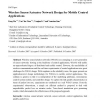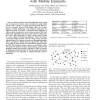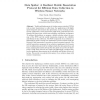2830 search results - page 76 / 566 » Mobile Agent Based Wireless Sensor Networks |
CORR
2008
Springer
14 years 10 months ago
2008
Springer
: Wireless sensor/actuator networks (WSANs) are emerging as a new generation of sensor networks. Serving as the backbone of control applications, WSANs will enable an unprecedented...
TMC
2008
14 years 9 months ago
2008
Recent research shows that significant energy saving can be achieved in wireless sensor networks by using mobile elements (MEs) capable of carrying data mechanically. However, the ...
TMC
2010
14 years 8 months ago
2010
—This paper proposes a framework to maximize the lifetime the wireless sensor network (WSN) by using a mobile sink when the underlying applications tolerate delayed information d...
JIPS
2010
14 years 4 months ago
2010
Wireless sensor networks consist of sensor nodes which are expected to be battery-powered and are hard to replace or recharge. Thus, reducing the energy consumption of sensor nodes...
DCOSS
2010
Springer
15 years 1 months ago
2010
Springer
Traditional deployments of wireless sensor networks (WSNs) rely on static basestations to collect data. For applications with highly spatio-temporal and dynamic data generation, su...



